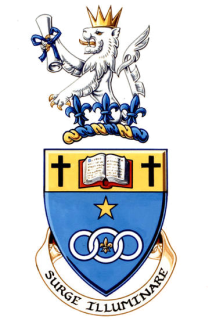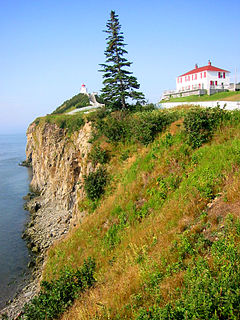
Claude Roussel CM ONB (born 1930) is a Canadian sculptor, painter and educator.

Claude Roussel CM ONB (born 1930) is a Canadian sculptor, painter and educator.
Roussel was born in 1930 in Edmundston, New Brunswick, Canada. He was 10 years old when he began sculpting wood. At the age of 14, Roussel's artistic possibilities was discovered by Dr. Paul Carmen Laporte (1885-1973, surgeon, artist and mentor) when Roussel shows him a plaque entitled Trout (1944), an artwork created using only a file and his own intuitive knowledge. [1] With Laporte's mentorship, Roussel advanced his wood carving techniques, and showed his early works at his first solo exhibition in 1947, at the age of 17, the year he completed his Lycée studies in Edmundston.
From 1950 to 1956, he studied under the tutelage of art professors at the École des beaux-arts de Montréal in Quebec, Canada, where he graduated with a diploma in drawing professorship in 1955, and a diploma in sculpture in 1956. [2] During his studies, Quebec’s artistic revolutions of Le Refus Global, 1948, and Les Automatistes, 1941-1960 played an influence on Roussel, who not only admired but practised within his own work their expressive forms of art, and implemented the use of bold colours and abstract forms. [3] In 1961, Roussel was awarded a Senior Fellowship from the Canada Council for the Arts to study Europe's important art, especially architectural decorations in England, France, Italy and Spain.
After completing his studies, Roussel returned to his hometown where he became the first professional artist to teach Education Through Art in the public school system of the province of New Brunswick. [4] From 1959 to 1961, Roussel was employed at the Beaverbrook Art Gallery in Fredericton as the first francophone occupying a curatorial position. During the public announcement of his appointment, Lord Beaverbrook stated "I think young Roussel will give the gallery a major liaison with the Acadian culture of this area and at the same time impart to our French Canadian artists a real sense of belonging". [5]
In 1963, at the invitation of Father Clément Cormier, vice chancellor and founder of University de Moncton, New Brunswick, and with a special grant from Canada Council for the Arts, Roussel became the first Artist-in-residence given the responsibility to develop the visual arts curriculum. He is the founding director of the university’s Visual Arts Department who occupied the position from 1963 to 1971, and again from 1976 to 1979. He is also the founding director of the university’s Art Gallery, from 1964 to 1967, during which he organized in 1964 an exhibition of Canadian masters - Borduas, Pellan, Riopelle et Dumouchel - and the first two major exhibitions of works by Acadian artists, Selection 65 and Selection 67. He retired from his position as professor in 1992 after a tenure of 29 years. [4]
Roussel was a member of the Maritime Education Foundation and the Jack Chambers Memorial Foundation. He was chair of Louise-et-Reuben-Cohen acquisition fund for the Art Gallery of the University of Moncton until 1991. From 1971-1976, he was the founding president of Canadian Artists Representation (CARFAC) representing New Brunswick. [2]
Roussel has been exhibited at more than 200 solo and group shows in Canada and internationally. His artworks are found in many countries but especially in Canada's eastern provinces. [2] Roussel has created more than 60 monumental and public art sculptures, twelve of which are listed below. [4]

Fredericton is the capital city of the Canadian province of New Brunswick. The city is situated in the west-central portion of the province along the Saint John River, which flows west to east as it bisects the city. The river is the dominant natural feature of the area. One of the main urban centres in New Brunswick, the city had a population of 63,116 and a metropolitan population of 108,610 in the 2021 Canadian Census. It is the third-largest city in the province after Moncton and Saint John.

New Brunswick is one of the thirteen provinces and territories of Canada. It is one of the three Maritime provinces and one of the four Atlantic provinces. It is the only province with both English and French as its official languages.

The Université de Moncton is a Canadian francophone university in New Brunswick. It includes campuses in Edmundston, Moncton, and Shippagan.

Riverview is a town in Albert County, New Brunswick, Canada. Riverview is located on the south side of the Petitcodiac River, across from the larger cities of Moncton and Dieppe. Riverview has an area of 34 square kilometres (13 sq mi), and a population density of 564.6 inhabitants per square kilometre (1,462/sq mi). Riverview's slogan is "A Great Place To Grow". With a population of 19,667 in 2016, Riverview is the fifth largest municipality in New Brunswick, having a larger population than the cities of Edmundston, Bathurst, Campbellton, and Miramichi, despite its designation of "town".
Sir James Hamet Dunn, 1st Baronet was a Canadian financier and industrialist during the first half of the 20th century. He is recognized chiefly for his 1935 rescue and subsequent 20-year presidency and proprietorship of Algoma Steel.

The Beaverbrook Art Gallery is a public art gallery in Fredericton, New Brunswick, Canada. It is named after William Maxwell "Max" Aitken, Lord Beaverbrook, who funded the building of the gallery and assembled the original collection. It opened in 1959 with over 300 works, including paintings by J. M. W. Turner and Salvador Dalí. The Beaverbrook Art Gallery is New Brunswick's officially designated provincial art gallery.
Municipal elections in the Canadian province of New Brunswick were held on May 10, 2004. All 104 municipalities in New Brunswick elected mayors and councillors. Also held on that day were elections for regional health boards and district education councils.

Phil Comeau, CM is a Canadian film and television director, born in Saulnierville, Nova Scotia. He lives in Moncton, New Brunswick and Montreal, Quebec.

There are two major national parks. The warmest salt water beaches north of Virginia can be found on the Northumberland Strait, at Parlee Beach in Shediac. New Brunswick's signature natural attraction are only a half hour's drive down the Petitcodiac river valley. The Confederation Bridge to Prince Edward Island is only an hour's drive east of Moncton.
Antoine Joseph Léger was a lawyer, author and political figure of Acadian descent in New Brunswick. He represented Westmorland County in the Legislative Assembly of New Brunswick from 1925 to 1935 as a Conservative member and then represented the division of L'Acadie in the Senate of Canada from 1935 to 1950.
Maurice Cullen is considered to be one of the first Impressionist artists in Canada. He is best known for his paintings of snow and for his ice harvest scenes where horse-drawn sleighs travel across the frozen waters of Quebec in the winter.
Aida Maud Boyer McAnn Flemming, was a Canadian teacher, writer and animal welfare advocate. She founded the Kindness Club, a humane education organization for children between the ages of 5 and 13. She was the wife of Hugh John Flemming, who was Premier of New Brunswick from 8 October 1952 to 11 July 1960.
The Irving Group of Companies is an informal name given to those companies owned and controlled by the descendants of Canadian industrialist K.C. Irving, namely his children J.K., Arthur, and Jack (1932–2010) and their respective children.
Bruno Bobak, LL.D., D.Litt was a Polish-born Canadian war painter and art teacher. His main medium was watercolour painting but he also produced woodcuts.
Anselme Chiasson was a Catholic priest, educator and writer in New Brunswick. Chiasson made significant contributions to the recording of Acadian history and folklore.
Janice Wright Cheney is a Canadian visual artist based in Fredericton, New Brunswick.
Brigadier Michael Wardell was a British-born army officer and publisher. In the 1950s and 1960s he owned and operated a publishing company, a daily newspaper and a monthly magazine in New Brunswick. He became a Canadian citizen in 1962. He was a close associate of Lord Beaverbrook from the mid 1920s until Beaverbrook's death in 1964.
The Centennial Building is an office building in downtown Fredericton, New Brunswick. Opened in March 1967, it was the province of New Brunswick's official Centennial project. At six storeys and 250,000 square feet (23,000 m2), it was designed to accommodate over 1000 provincial civil servants, who had been dispersed in more than 20 separate buildings in Fredericton, the province's capital city.
Roméo Savoie DFA is a Canadian postwar and contemporary artist. One of the first abstract painters in Eastern Canada, the artist's body of work includes more than 4,000 paintings, 50 buildings, six poetry anthologies, and one novel.
Herzl Kashetsky LL. D. is a realist painter, known for his commemorative work in paintings dedicated to victims of the Holocaust. The main body of his art has been figurative, and embedded in the representational.